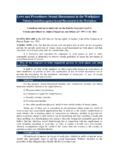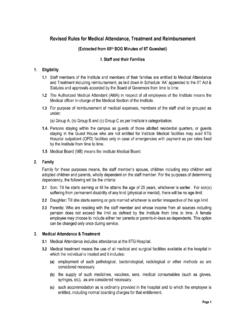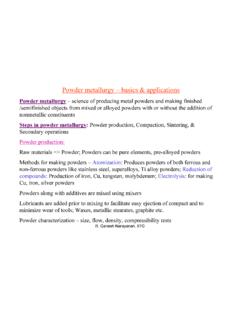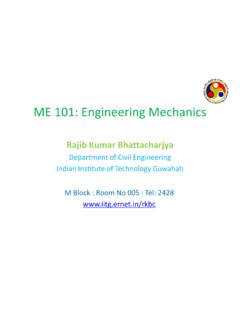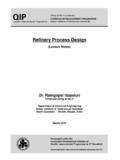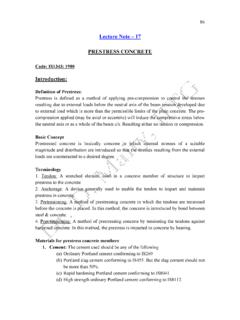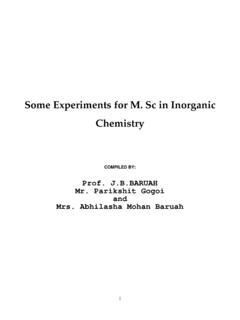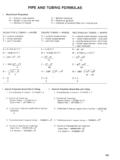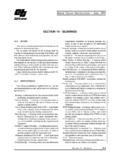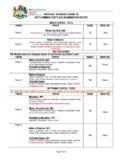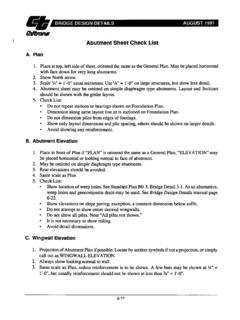Transcription of CHAPTER 14 TRANSVERSE VIBRATION OF EULER BEAM
1 CHAPTER 14 TRANSVERSE VIBRATION OF EULER BEAM It was recognized by the early researchers that the bending effect is the single most important factor in a transversely vibrating beam. The EULER -Bernoulli model includes the strain energy due to the bending and the kinetic energy due to the lateral displacement. The EULER -Bernoulli model dates back to the 18th century. Jacob Bernoulli (1654-1705) first discovered that the curvature of an elastic beam at any point is proportional to the bending moment at that point. Daniel Bernoulli (1700-1782), nephew of Jacob, was the first one who formulated the differential equation of motion of a vibrating beam. Later, Jacob Bernoulli's theory was accepted by Leonhard EULER (1707}1783) in his investigation of the shape of elastic beams under various loading conditions. Many advances on the elastic curves were made by EULER . The EULER -Bernoulli beam theory, sometimes called the classical beam theory, EULER beam theory, Bernoulli beam theory, or Bernoulli- EULER beam theory, is the most commonly used because it is simple and provides reasonable engineering approximations for many problems.
2 However, the EULER -Bernoulli model tends to slightly overestimate the natural frequencies. This problem is exacerbated for the natural frequencies of the higher modes. Mathematical formulation: wxdx Figure 1: A beam under TRANSVERSE VIBRATION Consider a long slender beam as shown in figure 1 subjected to TRANSVERSE VIBRATION . The free body diagram of an element of the beam is shown in the figure 2. Here, is the bending moment, is the shear force, and is the external force per unit length of the beam. Since the inertia force acting on the element of the beam is ),(txM),(txV),(txf22),()(ttxwdxxA 247 Figure 2: Freebody diagram of a section of a beam under TRANSVERSE VIBRATION balancing the forces in direction gives z22),()(),()(ttxwdxxAVdxtxfdVV =+++ , where is the mass density and is the cross-sectional area of the beam. The moment equation about the )(xAy axis leads to 02),()()(= ++ +MdxdxtxfdxdVVdMM By writing dxxVdV = and dxxMdM = and disregarding terms involving second powers in , the above equations can be written as dx22),()(),(),(ttxwxAtxfxtxV =+ 0),(),(= txVxtxM By using the relation xMV = from above two equations 2222),()(),(),(ttxwxAtxfxtxM =+ 248 From the elementary theory of bending of beam, the relationship between bending moment and deflection can be expressed as 22),()(),(xtxwxEItxM = where E is the Young s modulus and is the moment of inertia of the beam cross section about the axis.
3 Inserting above two equations, we obtain the equation of the motion for the forced TRANSVERSE VIBRATION of a non-uniform beam: )(xIy),(),()(),()(222222txfttxwxAxtxwxEI x= + For a uniform beam above equation reduces to ),(),()(),()(2244txfttxwxAxtxwxEI= + For free VIBRATION ,, and so the equation of motion becomes 0),(=txf0),(),(22442= + ttxwxtxwc where AEIc = Initial Conditions: Since the equation of the motion involves a second order derivative with respect to time and a fourth order derivative with respect to, two initial equations and four boundary conditions are needed for finding a unique solution for. Usually, the values of TRANSVERSE displacement and velocity are specified as and atx),(txw)(0xw)( , so that the initial conditions become: )()0,(0xwtxw== )()0,( = Free VIBRATION : The free VIBRATION solution can be found using the method of separation of variables as )()(),(tTxWtxw= 249 Substituting this equation in the final equation of motion and rearranging leads to 222442)()(1)()( == =adttTdtTdxxWdxWc where is a positive constant.
4 Above equation can be written as two equations: 2 =a0)()(444= xWdxxWd 0)()(222=+tTdttTd where, EIAc2224 == The solution to time dependent equation can be expressed as tBtAtT sincos)(+= where, A and B are constant that can be found from the initial conditions. For the solution of displacement dependent equation we assume, sxCexW=)( where C and are constant, and derive the auxiliary equation as: s =2,1s, is =2,1 Hence the solution of the equation becomes: xixixxeCeCeCeCxW +++=4321)( where,, and are constant. Above equation can also be expressed as: 1C2C3C4 CxCxCxCxCxW sinhcoshsincos)(4321+++= or, ()()()(xxCxxCxxCxxCxW) sinhsinsinhsincoshcoscoshcos)(4321++++ ++= The constants,, and can be found from boundary conditions. The natural frequencies of the beam are computed from: 1C2C3C4C()422 AlEIlAEI == 250 The function is known as normal mode or characteristic function of the beam and )(xW is called the natural frequency of VIBRATION .
5 For any beam, there will be infinite number of normal modes with one natural frequency associated with each normal mode. The unknown constant,, and and value of 1C2C3C4C can be determined from boundary conditions of the beam. Boundary Conditions: Hinged, M(0, t) =0, D(0, t) =0; Free, M(0, t)=0, Q(0, t)=0 1. Free End: Bending Moment =022= xwEI, Shear Force =022= xwEIx. 2. Simply supported (pinned) end: Bending Moment =022= xwEI, Deflection =0=w. The value of nL is unknown and is determined using the boundary condition of the beam given. For different boundary conditions we get different equations. While the case of simply supported beam admits a closed form solution, the other equation has to be solved numerically. All these equations have a number of solutions each corresponding to different modes of VIBRATION . The first, second and third positive solutions were determined for 251each case and the solutions obtained are used to determine the frequencies of VIBRATION for three modes.
6 1. Free End: Frequency Equation: 0sin=ln , Mode Shape: xCwnnn sin= . 32321===lll 2. Simply supported (pinned) end: Frequency Equation: Mode Shape: () + ++=xxxxxxxxCwnnnnnnnnnn coshcoscoscoshsinhsinsinhsin We now consider the effect of different masses at different locations. A lower bound approximation method Dunkerley s Equation is used to determine the frequency with lumped masses attached to the beam. The Dunkerleys formulae is given as sysbeamsysbeamiwherefundamental frequencyof thetotal systemfundamental frequencyof thebeamalonefundamentalfrequencyof theith massmountedonthe beamalone =+++=== The natural frequency of the mass alone is determined from the static deflection value obtained by using the strength of materials theory 2()/iiiFKxKm = = Rigorously speaking, all real system are continuous system A continuous system for analysis purpose can be reduces to a finite number of discrete models.
7 Each discrete model can be reduced to an eigenvalue problem. In can of continuous systems the solution yield infinite number of eignvalus and eigenfunctions where as in discrete system the number of eignvalues and vector are finite. The concept of orthogonality is applicable to both discrete and continuous systems. The eigen value problem in case of discrete system takes the from of algebraic equations while in continuous systems differential equations and some times integral equations are obtained. Eigenvectors of the discrete system becomes eigenfunction of the continuous system. Geometric boundary conditions (or essential or imposed boundary conditions) resulting from conditions of purely geometric compatibility Ex Boundary conditions Here, deflections and slope at both ends are zero constitute geometric s Natural boundary conditions (additional or dynamic ) resulting from the balance of moments or forces.
8 253 Bending moment is zero at both the ends. So in case of a simply supported beam, the natural boundary conditions are bending moment is zero at both the ends and in geometric boundary condition is deflections are are zero at both the ends. For a cantilever beam, while the fixed end has geometric bcs (deflection and slope zero) and free end has natural bcs (shear force and bending moment zero) Approximate methods In exact method difficulties arises in Solving roots of the characteristic equation. Except for very simple boundary conditions, one has to go for numerical solution. In determining the normal modes of the system Determination of steady state response So quick for determination of the natural frequencies of a system, when a very accurate result is not of much importance one should go for an approximate method.
9 Modeling . ApproximationSeriessolutionApproximate method where approximation error should be within acceptable limits one may assume a series solution as == 0)()(),(nnnxtftxy (1) where ( )nx is the normal modes and ( )nftis the time function which depends upon initial conditions and forcing function. There are certain difficulties that limit the application of classical analysis of continua to a very simple geometries only. The infinite series sometimes converge very slowly and it is difficult to estimate how many terms are needed for engineering accuracy. The formulation and computation efforts are prohibitive for systems of engineering complexity. 254 The special methods (as approximate methods) treat the continuous systems, for VIBRATION analysis purpose, as discrete systems. This can be done with one of the following methods.
10 Retaining n natural modes only and considering them as generalized coordinates and computing the n weighing functions fn(t) to best fit the initial conditions or the forcing functions. Substituting for the n modes an equal number of known functions n(x) that satisfy the geometric conditions of the problem and then compute the functions fn(t) to best fit the differential equation, the remaining boundary conditions, and the intitial conditions of the forcing functions. Taking as generalized coordinates the n physical conditions of a certain number of points of the system q, (q,"qn) considering them as functions of time, and computing them to fit the differential equation; and the initial and boundary conditions. The main advantage of all theses methods is that instead of dealing with one or more partial differential equations, one deals with a larger number of ordinary differential equations (usually liner with constant coefficients) which are particularly suitable for solution in fast computing machines.

